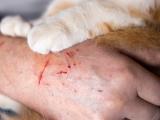"We haven't described anything that isn't well-known in the field."
That's how David Evans, PhD, professor of medical microbiology and immunology at the University of Alberta, defends his latest study involving potentially dangerous research published recently in PLoS One.
The study, titled, "Construction of an infectious horsepox virus vaccine from chemically synthesized DNA fragments," has caused a stir because it offers a step-by-step account of how Evans and his team recreated the horsepox virus (HPX) using synthesized DNA fragments based on HPX and vaccinia virus genomes. The virus was then used to develop a novel vaccinia vaccine tested in mice.
Pathway to smallpox?
The work generated criticism from global biosecurity experts who say that offering a manual for re-creating an orthopoxvirus is an inherently dangerous proposition. They fear being that Evans and his team have offered rogue states, terrorists, or others a how-to guide to recreating the world's most dangerous orthopoxvirus—smallpox.
"This is the first time an orthopoxvirus has even been synthesized, which means there's now a new pathway for redeveloping the smallpox virus even though it's eradicated in nature," said Greg Koblentz, PhD, the director of the biodefense graduate program at George Mason University, in an interview. Besides laboratory samples maintained by the United States and Russia, smallpox cannot be found in the world.
Elizabeth Cameron, PhD, the vice president of global biological policy and programs at the Nuclear Threat Initiative (NTI), issued a statement calling for dialogue to develop clear norms for reducing the biological risks posed by such research. "It's clear that the capability to create and modify biological agents is outpacing governmental oversight and public debate," she wrote.
Vaccinia vaccine using dual-use research
Evans said the goal of the research was to understand recombinant viruses and develop new vaccines. Also published last Friday was research from the same group showing that mice were successfully immunized against vaccinia virus using the horsepox-developed vaccine.
Controversial "dual-use" research refers to studies that can be used for both beneficial and nefarious purposes.
"We have very old vaccine technologies that date back to the 1980s," Evans said. "They work but are clunky if you are trying to really modify a virus, so we were interested in taking advantage of technology and developing better tools."
Evans said his team worked with advisors with Canada's federal government who approved the work. He also said that although he may have been the first to recreate HPX, he's not the only scientists capable of doing so.
"There are publications on how to reactivate pox viruses dating back to the 1970s and 1980s," said Evans. "It doesn't take a rocket scientist to produce a pox virus. I worry about the people that say you've provided a blueprint. Implicit in that is that other scientists couldn't do it. But many could. They don't need blueprints."
Still, the paper concludes with a warning: "Most viruses could be assembled nowadays using reverse genetics, and these methods have been combined with gene synthesis technologies to assemble poliovirus and other extinct pathogens like the 1918 influenza strain… our studies show that it is clearly accessible to current synthetic biology technology, with important implications for public health and biosecurity."
Koblentz said that any dual-use research must consider what could be gained from the work. In this particular instance, Koblentz said there's no need to use this data to create new smallpox vaccines (the paper also suggests that the work could be embraced as a tool to develop new oncolytic agents).
"The benefits promised by the research are illusory, unneeded, and unlikely even," said Koblentz. "They're trying to solve a problem that doesn't exist."
See also:
Jan 19 PLoS One study
Jan 22 NTI statement











